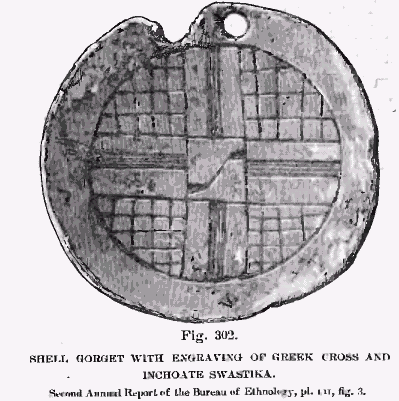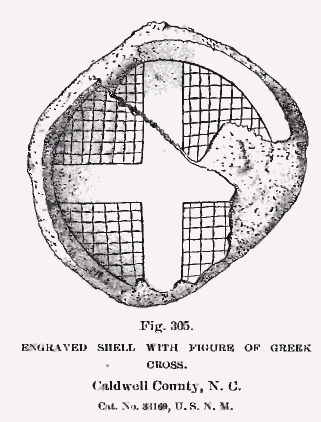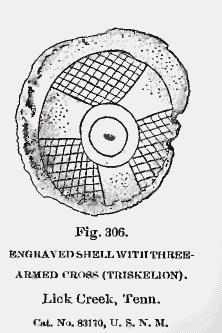

The Swastika
Dispersion of the Swastika

 style
as fig. 238 from Tennessee.
The circles and central dots of
fig. 238 have a similarity to Peruvian ornamentation. The form and
style, the broad arms, the circles and central dots, the lines of engravings,
show such similarity of form and work as mark this specimen as a congener
of the Swastika from Fains Island (fig.
237). The other objects found in the mound associated with this Swastika
will be described farther on.
style
as fig. 238 from Tennessee.
The circles and central dots of
fig. 238 have a similarity to Peruvian ornamentation. The form and
style, the broad arms, the circles and central dots, the lines of engravings,
show such similarity of form and work as mark this specimen as a congener
of the Swastika from Fains Island (fig.
237). The other objects found in the mound associated with this Swastika
will be described farther on. There can be no doubt of these figures being the genuine Swastika, and that they were of aboriginal workmanship. Their discovery immediately suggests investigation as to evidences of communication with the Eastern Hemisphere, and naturally the first question would be, Are there any evidences of Buddhism in the Western Hemisphere? When I found, a few days ago, the two before-described representations of Swastikas, it was my belief that no reliable trace of Buddha or the Buddhist religion had ever been found among the aboriginal or prehistoric Americans. This statement was made, as almost all other statements concerning prehistoric man should be, with reserve, and subject to future discoveries, but without idea that a
 discovery
of evidence on the subject was so near. In searching the U. S. National
Museum for the objects described in the Second Annual Report of the Bureau
of Ethnology under the title of "Art in shell among the Ancient Americans,"
the writer discovered a neglected specimen of a mutilated and damaged
shell (pl. 10), marked as shown
on the back, found by Mr. Emmert, an employé of the Buereau of
Ethnology, in the year 1882. Its original field number was 267, Professor
Thomas's 6542, the Museum number 115562, and it was found in the Big Toco
mound, Monroe County, Tenn. It is not figured nor mentioned in any of
the Bureau reports. It is greatly to be regretted that this shell is so
mutilated. In its present condition on one can say positively what it
is, whether a statue of Buddha or not; but to all appearances it represents
one of the Budddhist divinities. Its material, similar to the hundred
others found in the neighborhood, shows it to have been indigenous, yet
parts of its style are different from other aboriginal North American
images. Attention is called to the slim waist, and the winged arms, the
crossed legs, the long feet, breadth of toes, the many dots and circles
shown over the body, with triple lines of garters or anklets. All these
show a different dress from the ancient North American. The girdle about
the waist, and the triangular dress which, with its decorations and arrangement
discovery
of evidence on the subject was so near. In searching the U. S. National
Museum for the objects described in the Second Annual Report of the Bureau
of Ethnology under the title of "Art in shell among the Ancient Americans,"
the writer discovered a neglected specimen of a mutilated and damaged
shell (pl. 10), marked as shown
on the back, found by Mr. Emmert, an employé of the Buereau of
Ethnology, in the year 1882. Its original field number was 267, Professor
Thomas's 6542, the Museum number 115562, and it was found in the Big Toco
mound, Monroe County, Tenn. It is not figured nor mentioned in any of
the Bureau reports. It is greatly to be regretted that this shell is so
mutilated. In its present condition on one can say positively what it
is, whether a statue of Buddha or not; but to all appearances it represents
one of the Budddhist divinities. Its material, similar to the hundred
others found in the neighborhood, shows it to have been indigenous, yet
parts of its style are different from other aboriginal North American
images. Attention is called to the slim waist, and the winged arms, the
crossed legs, the long feet, breadth of toes, the many dots and circles
shown over the body, with triple lines of garters or anklets. All these
show a different dress from the ancient North American. The girdle about
the waist, and the triangular dress which, with its decorations and arrangement<< Previous Page Next Page >>
© 2004-2007 Northvegr.
Most of the material on this site is in the public domain. However, many people have worked very hard to bring these texts to you so if you do use the work, we would appreciate it if you could give credit to both the Northvegr site and to the individuals who worked to bring you these texts. A small number of texts are copyrighted and cannot be used without the author's permission. Any text that is copyrighted will have a clear notation of such on the main index page for that text. Inquiries can be sent to info@northvegr.org. Northvegr™ and the Northvegr symbol are trademarks and service marks of the Northvegr Foundation.

|